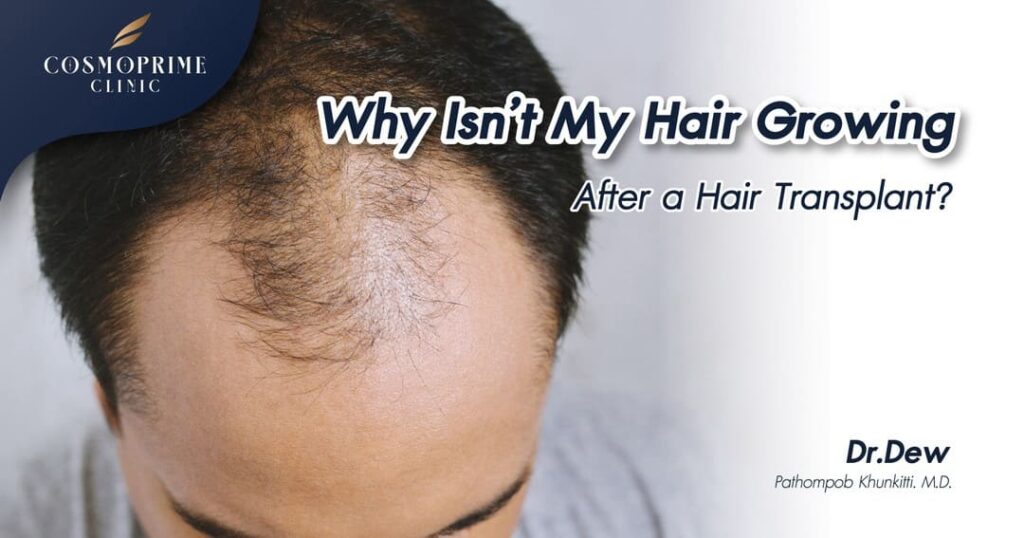Investing in a hair transplant can be a significant financial and emotional decision. So, what happens if your hair doesn’t grow after the procedure? Is all that money and effort wasted?
Despite the promising before-and-after photos showcased by clinics, not everyone achieves the same results. Let’s explore the common reasons why a hair transplant may fail and what you can do about it.
5 Main Causes of Hair Not Growing After a Hair Transplant

1. Lack of Expertise in the Surgical Team
A successful hair transplant requires the combined skill of both the surgeon and the medical team. Any errors during the procedure can directly affect hair growth.
Surgeon’s Experience Matters
An inexperienced surgeon may damage the hair follicles during extraction or implantation, preventing them from thriving. Proper technique is essential to preserve follicle viability.
Role of the Medical Team
Technicians assist with critical tasks like:
- Preparing the grafts.
- Carefully handling follicular units.
- Ensuring the grafts stay hydrated and viable during surgery.
If the team lacks experience, it can lead to follicle death before implantation.
2. Prolonged Surgery Duration
The length of your surgery can impact the survival rate of the hair grafts. A typical hair transplant takes approximately 6-8 hours.
Why Longer Surgery Can Be Risky:
- Graft Dehydration: Hair follicles are delicate and can die if left outside the body too long.
- Increased Risk of Infection: Prolonged exposure during surgery raises the risk of scalp infection.
Factors that may extend the surgery include:
- Patient-specific conditions (e.g., bleeding disorders).
- Poor surgical planning.
- Inadequate team coordination.
3. Quality of Equipment and Tools
Outdated or poorly maintained equipment can impact the accuracy and efficiency of the transplant procedure. Modern, advanced tools allow for:
- Precise Graft Extraction: Minimizing damage to the donor site.
- Accurate Implantation: Ensuring proper depth and angle for natural growth.
If the clinic uses substandard equipment, there is a higher chance of poor results.

4. Post-Operative Care
The first 1-14 days after your hair transplant are crucial for graft survival. Failure to follow aftercare instructions can lead to graft loss.
Common Post-Care Mistakes That Affect Hair Growth:
- Touching or Scratching the Scalp: This can dislodge fragile grafts.
- Sleeping Incorrectly: Sleeping flat may cause pressure on the implanted area.
- Ignoring Signs of Infection: Pimples or redness at the graft site can indicate infection.
5. Unpredictable Patient Factors
Some variables are beyond the clinic’s control but can significantly impact your results.
Key Factors That Affect Hair Growth:
- Pre-Existing Medical Conditions:
- Autoimmune diseases (e.g., alopecia areata).
- Hormonal imbalances.
- Lifestyle Choices:
- Smoking and alcohol use can reduce blood flow and delay healing.
- Poor nutrition weakens hair follicle health.
- Scalp Health:
- Chronic inflammation can interfere with new growth.
How Long Does It Take for Hair to Grow After a Transplant?
Hair growth after a transplant follows a typical timeline:
- 1-3 Months: Initial shedding phase (normal “shock loss”).
- 3-6 Months: Early signs of new hair growth.
- 6-12 Months: Significant growth and thickness.
- 12-18 Months: Final results become fully visible.
If no noticeable hair growth occurs by 6-12 months, consult your doctor for further evaluation.
What to Do If Your Hair Isn’t Growing
If your hair is not growing as expected, consider these steps:
✅ Consult Your Surgeon: Request a follow-up to identify potential causes.
✅ Follow a Healthy Lifestyle: Maintain a balanced diet and avoid smoking.
✅ Use Hair Growth Treatments: Your doctor may recommend Minoxidil or PRP therapy to boost growth.
Final Thoughts – Why Hair May Not Grow After a Hair Transplant
A successful hair transplant relies on surgical expertise, proper post-care, and individual health factors. If your hair isn’t growing, early intervention and specialized care can often improve the outcome.



